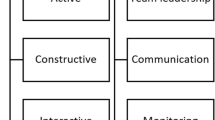Abstract
In the business-systems-design learning environment, there may be more than one solution to any given problem. For instance, the data model will be different depending on each learner’s perspective. Accordingly, group learning systems are very effective in this domain. We have developed a collaborative and multimedia environment for learners on teams (CAMELOT) using the ‘nominal group technique’ for group problem solving. In this paper, the basic framework of the collaborative learning system and the effectiveness of collaborative learning in designing the data model are described. By using CAMELOT, each learner learns how to analyse through case studies and how to collaborate with his or her group in problem solving. Learners come to a deeper understanding from using CAMELOT than from studying independently because they can reach better solutions through discussion, tips from other learners and examination of one another’s individual works.
Similar content being viewed by others
Explore related subjects
Discover the latest articles, news and stories from top researchers in related subjects.References
Brightman, H. J. (1988)Group Problem Solving: An Improved Managerial Approach: College of Business Administration, Atlanta, Georgia: Georgia State University.
Chan, T. W. and Baskin, A. B. (1988) Studying with the Prince: the computer as a learning companion. InProceedings of the Intelligent Tutoring Systems, Montreal, Canada, June 1–3, 1988, pp, 194–200.
Conklin, J. and Begeman, M. L. (1988) gIBIS: a hypertext tool for exploratory policy discussion.ACM Transactions on Office Information Systems 6(4), 303–31.
Fuji, T., Tanigawa, T., Hoshihara, K., Ito, S., Kozeni, M. and Saegusa, T. (1993)Prototype system of advanced and individualized CAI with OMT, IPSJ SIG. Notes 93-SE-92, Tokyo, Japan: Information Processing Society in Japan, pp. 17–26.
Fuji, T., Tanigawa, T., Inui, M. and Saegusa, T. (1995) CAMELOT: collaborative and multimedia environment for learners on teams. In I. Selwood, P. Fox and M. Tebbutt (eds)Abstracts, Sixth IFIP World Conference on Computers in Education, Birmingham, 23rd–28th July 1995, p. 104.
Gamma, E., Marty, R., and Weinand, A. (1989) ET++: a portable C++ class library for a UNIX environment. Tutorial 13,Conference on Object-Oriented Programming Systems, Languages and Applications ’89, New Orleans, LA.
Hoppe, H. U., Baloian, N. and Zhao, J. (1993)Computer Support for Teacher-Centered Classroom Interaction, Report of Gesellschaft für Mathematik und Datenverarbeitung Mbh 750, Germany.
Kanda, Y., Watanabe, I., Misue, K., Hiraiwa, H., and Masui, M. (1993) Group idea processing system: GrIPS.Journal of Japanese Society for Artificial Intelligence 8(5), 601–10.
Katz, S. and Lesgold, A. (1992)The role of the tutor in computer-based collaborative learning situations. Report of the University of Pittsburgh, PA.
Koschmann, T. D. (1994) Toward a theory of computer support for collaborative learning.Journal of the Learning Sciences 3(3), 219–25.
Koschmann, T. D., Myers, A. C., Feltovich, P. J. and Barrows, H. S. (1994) Using technology to assist in realizing effective learning and instruction.Journal of the Learning Sciences 3(3), 227–64.
Pea, R. D. (1994) Seeing what we build together: distributed multimedia learning environments for transformative communications.Journal of the Learning Sciences 3(3), 285–99.
Rittel, H. and Kunz, W. (1970)Issues as elements of information systems. Working Paper No. 131, Institute of Urban and Regional Development, University of California at Berkeley, CA.
Rumbaugh, J., Blaha, M., Premerlani, W., Eddy, F. and Lorensen, W. (1991)Object-Oriented Modeling and Design. Englewood Cliffs, NJ: Prentice-Hall.
Scardamalia, M. and Bereiter, C. (1994) Computer support for knowledge-building communities.Journal of the Learning Sciences 3(3), 265–83.
Shimazaki, K., Okubata, K., Sakane, K., Nomura, Y., Ohta, Y., Ikeda, M. and Mizoguchi, R. (1993) Operation of tutoring strategies for FITS.Transactions of the Japanese Society for Artificial Intelligence 8(2).
Woolf, B. P. (1984) Context dependent planning in a machine tutor. COINS Technical Report, 84-21, University of Massachusetts: Cambridge, MA.
Author information
Authors and Affiliations
Rights and permissions
About this article
Cite this article
Fuji, T., Tanigawa, T., Inui, M. et al. CAMELOT: collaborative and multimedia environment for learners on teams. Educ Inf Technol 1, 203–226 (1996). https://doi.org/10.1007/BF02350659
Issue Date:
DOI: https://doi.org/10.1007/BF02350659




